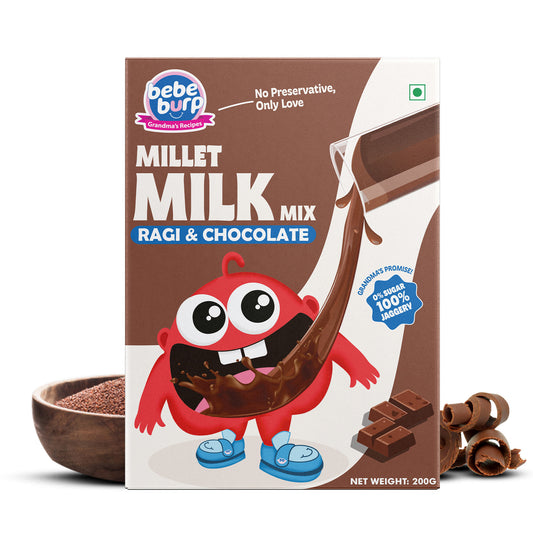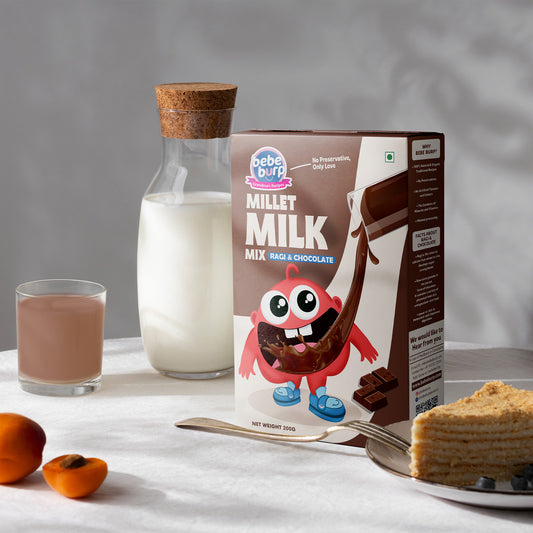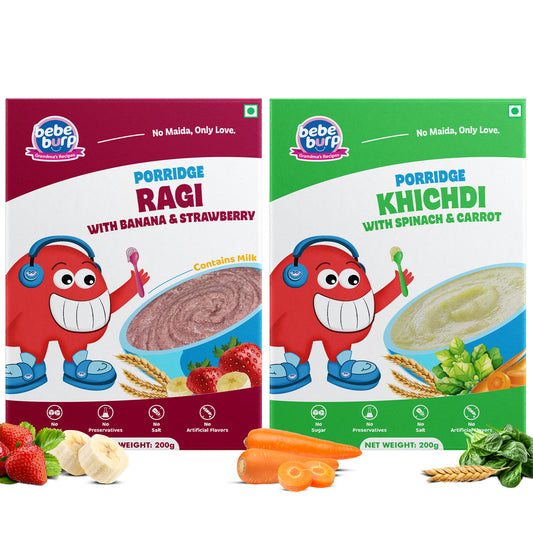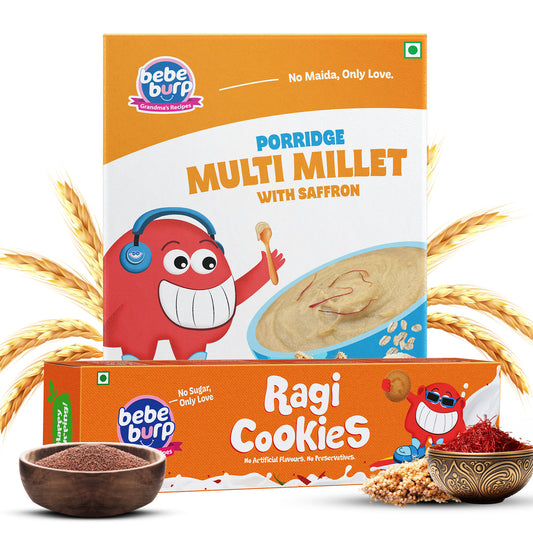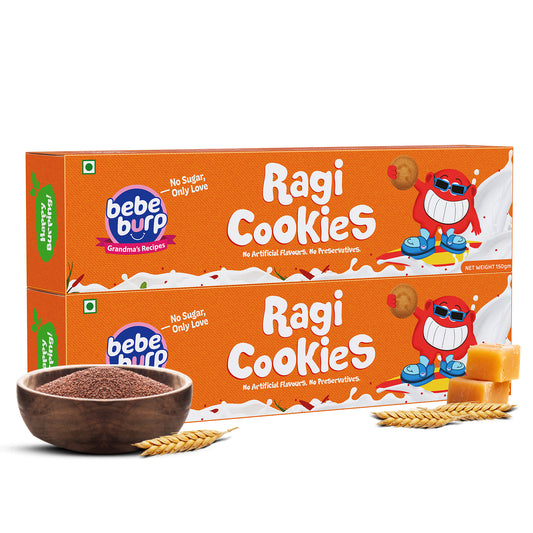Ragi porridge maintains its status as a long-time family staple throughout India because of its nutritious advantages.
Ragi porridge maintains its status as a long-time family staple throughout India because of its nutritious advantages.
Medical evidence supports this food because it is a superfood that specifically benefits infants and children during their growth stages.
This guide shows why ragi porridge is a good child nutrition option. It includes step-by-step preparation instructions and innovative meal ideas to keep children interested.
Why Ragi Porridge is a Superfood for Infants
- The vitamin and mineral content of Ragi includes calcium together with iron fiber and protein which support an infant's growth along development.
- The smooth digestion of ragi benefits infants because this food item shows kindness to the stomach.
- Ragi provides antioxidants to develop your baby's immunity function.
- The dietary solution is ideal for babies who react poorly to gluten.
Nutritional Benefits of Ragi Porridge for Growing Children

Ragi porridge delivers maximum nutrition benefits to its consumers. The following aspects serve to announce health benefits to growing children in particular:
- High in Calcium: Supports bone and teeth development, essential for growing children.
- Ragi brings rich iron content that helps defend against anemia while improving body oxygen circulation.
- The access to dietary fibre in this food helps promote digestive health while maintaining regular bowel movements.
- Protein content in ragi porridge helps children build and develop their muscles.
- Due to its low Glycemic Index rating, sugar levels stay uniform, which avoids energy-dropping incidents.
Preparing the Perfect Ragi Porridge: A Step-by-Step Guide

Preparation of ragi porridge does not consume much time since it is an easy process. Follow this procedure to make ragi porridge:
Ingredients:
- 2 tablespoons of ragi flour
- One cup of water or milk serves as the basis for the child's age group.
- A pinch of cardamom or cinnamon (optional)
- A sweetener like jaggery or honey (optional)
Method:
- Mix ragi flour into water or milk until the consistency becomes smooth using a pan.
- Stir the mixture continuously because low heat helps to create a smooth paste without the formation of lumps.
- The mixture reaches the desired thickness after 5 to 10 minutes so it should be taken off the heat.
- Adding cardamom or cinnamon with a light pinch will help to flavour the mixture.
-
Add jaggery or honey as a sweetener for your child (only after they turn 1 year old).
Serving:
Serve the porridge to your baby when it reaches the proper temperature after it has cooled.
Age-Wise Ragi Porridge Introduction and Serving Guidelines

You should offer ragi porridge during the appropriate age period while making it the right texture for eating purposes.
6-8 Months:
A porridge with smooth and fluid characteristics serves as an appropriate beginning.
Serve 2-3 teaspoons once a day.
9-12 Months:
The amount of ragi porridge should rise from 2-3 teaspoons to 4-5 teaspoons.
The mixture can be combined with vegetable purees along with fruits to add both flavor and nutritional content.
1 Year+:
Serve a thicker consistency. More diversity in ragi porridge can result from the addition of nuts or dry fruits with their unique flavors.
Creative Ragi Porridge Recipes and Variations

Ragi porridge presents itself as a versatile dish that becomes more exciting after minor adjustments. You can enjoy your ragi porridge in various entertaining ways, as described below.
Blend half a banana in ragi porridge until it becomes a naturally sweetened velvet mixture.
A puree of apple pear or mango, when combined with ragi porridge, results in an exciting fruity meal.
Savory Ragi Porridge:
To create savoury ragi porridge, you should mix a pinch of salt with mild spices and add ghee.
Ragi with Yogurt:
Ragi porridge serves as a simple probiotic-rich snack after mixing it with yogurt when it reaches room temperature.
Common Myths and Truths About Ragi Porridge
We will elaborate on a few myths related to ragi porridge.
Myth: Only babies should eat ragi porridge.
Reality: Ragi porridge is suitable for both children and adults. It is a healthy dish for every human being.
Myth: It is difficult to digest ragi porridge.
Reality: Well-cooked ragi porridge can be easy to digest, and it has additional benefits that help improve overall digestion.
Myth: Ragi is tasteless and bland.
Reality: If prepared the right way, Ragi porridge is both delicious and nutritious, as Ragi can be blended perfectly with the right spices, fruits, or sweeteners.
Ragi Porridge Preparation Challenges
The preparation process of ragi porridge is basic, though several minor obstacles can occur during cooking.
- Ragi flour produces clumps as it boils. Stirring your cooking mixture continuously stands as the essential step to prevent this problem from occurring.
- Too Thick or Too Runny: Add more water or milk to the consistency. The porridge consistency should always stay at your chosen level of thickness.
- Some infants need time to develop a preference for the new taste in their meals.
- Introduce the taste with mixed porridge recipes containing milk and familiar fruits to neutralize the flavour.
Beyond Porridge: Innovative Ways to Include Ragi in Child's Diet

You can use ragi flour for more than making porridge since it has multiple beneficial applications. The following dietary suggestions will assist you in including ragi flour in your child's diet plan:
- Ragi Pancakes: serve as nutritious breakfast food that replaces traditional flour with ragi flour.
- Ragi Dosa: Prepare a savory dosa (crepe) from ragi flour for a different texture.
- Ragi Balls: represent nutrient-rich sweet balls made from ragi flour blended with jaggery along with ghee.
- Ragi Cookies: Bake delicious and healthy cookies with ragi flour for snack time.
Expert Insights and Recommendations
The nutritional advantages of ragi porridge as a child food receive complete support from both nutrition experts and pediatric specialists. Here are some expert insights:
- Variety is essential because ragi porridge remains nutritious, yet it pairs well with additional grains, veg, vegetables, and fruit to develop balanced meals.
- You should provide ragi porridge to your baby at approximately six months old, so they obtain diverse nutritional elements since inception.
- The porridge texture needs adjustment according to how well the child chews and their current age.
Conclusion
Parents should introduce ragi porridge to their children because it brings essential nutrients through a nutritious, versatile eating option that requires minimal cooking skills.
Ragi porridge provides children with necessary vitamins that promote proper growth and nourish their digestive systems while strengthening their immune response.
No need to worry about your child avoiding healthy meals since you can easily modify the recipes to keep ragi porridge exciting.
FAQs
Q1) The question arises about whether parents should offer ragi porridge to their babies younger than six months.
Ans: The medical standard advises introducing solid foods only after reaching six months of age. Seek guidance from your pediatrician concerning suitable guidance.
Q2) Babies who suffer from gluten intolerance can consume ragi porridge safely.
Ans: Ragi contains no gluten thus making it perfectly suitable food for babies who cannot tolerate gluten.
Q3) Is there a frequency limit for giving ragi porridge to my child?
Ans: The daily consumption of ragi porridge remains allowed, although you must introduce diversity into your child's meals.
Q4) Is ragi flour appropriate for feeding to both children and adults?
Ans: The consumption of ragi flour suits youngsters who have reached their first birthday as well as when used in adult foods.


